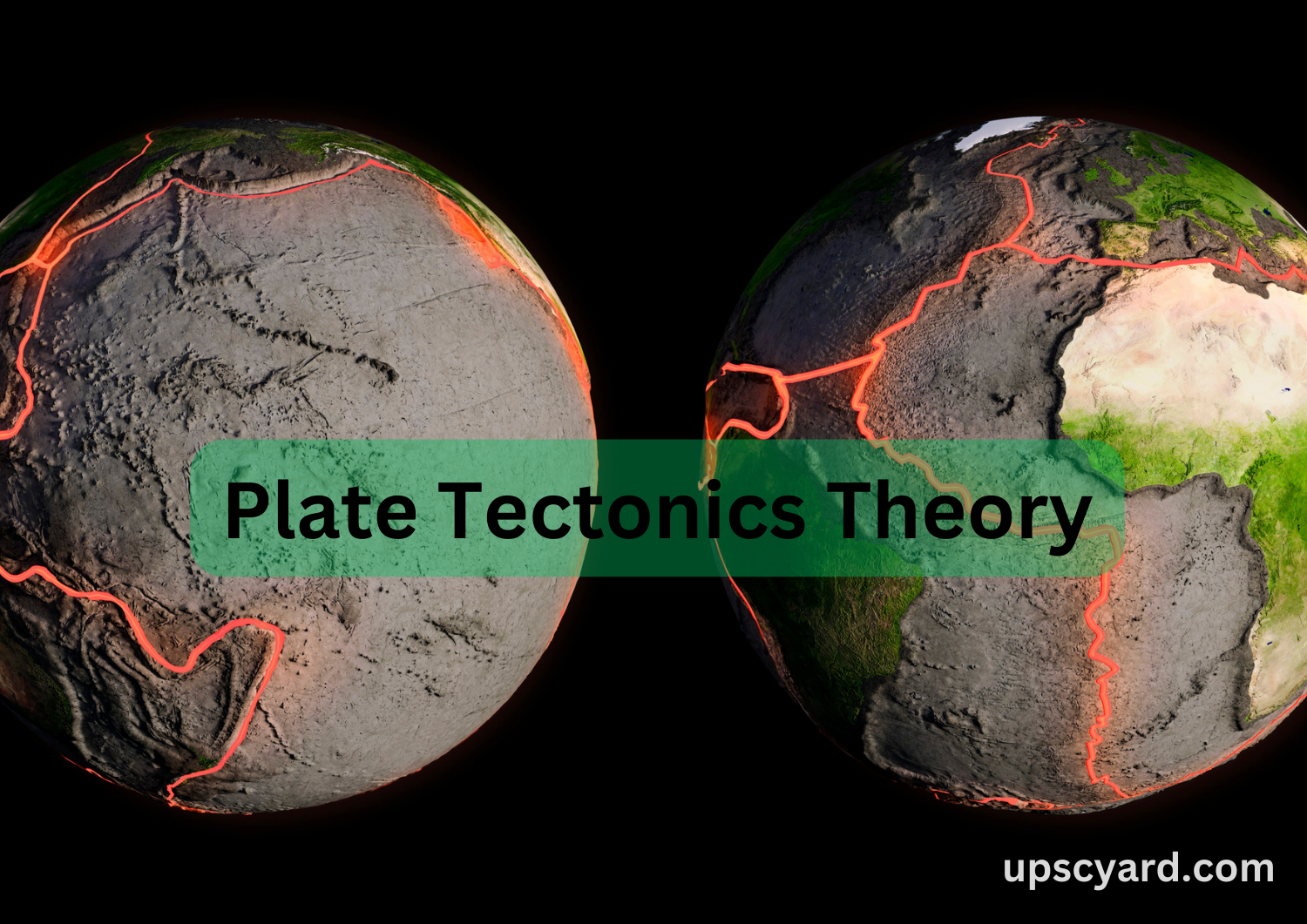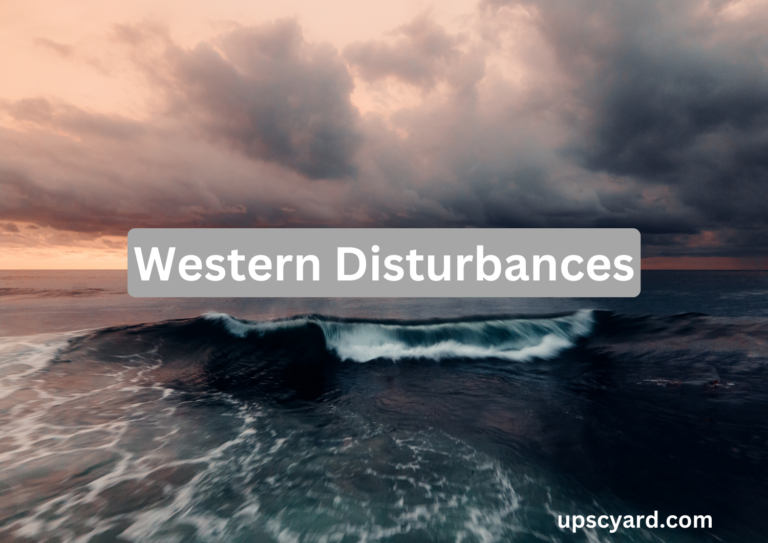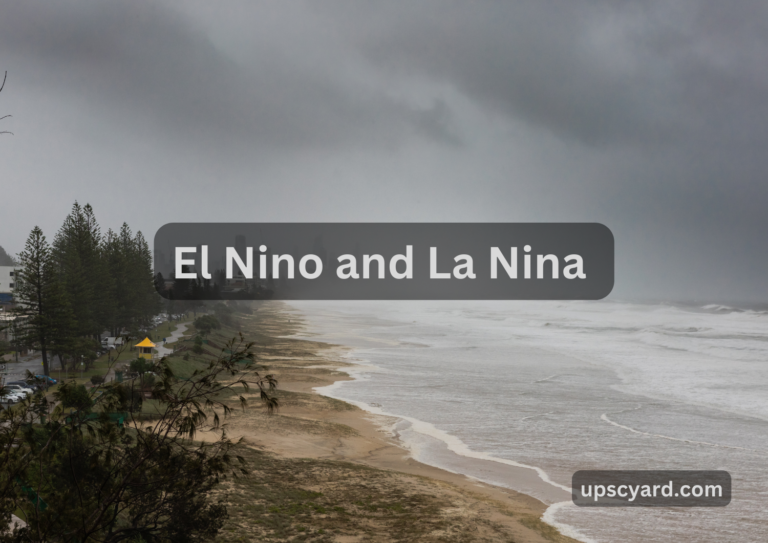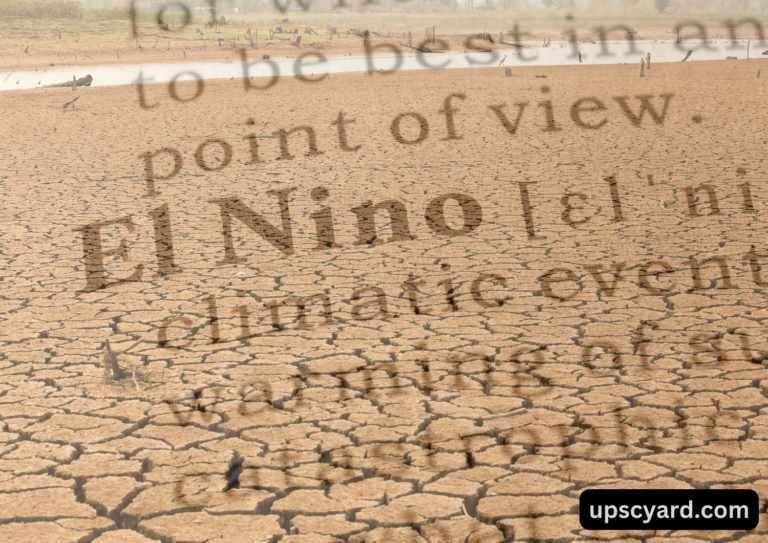Plate Tectonics Theory : Unveiling Earth’s Dynamic Puzzle
The theory of Plate Tectonics, a cornerstone of modern geology, emerged in 1967 through the insights of McKenzie and Parker, followed by Morgan’s elucidation in 1968. It harmoniously incorporates the pre-existing notions of continental drift, convection currents, and seafloor spreading.
According to this captivating theory, Earth’s lithosphere is a mosaic of distinct plates, adrift on a malleable layer known as the asthenosphere, nestled in the upper mantle. These plates maneuver horizontally over the asthenosphere’s surface, maintaining their structural integrity.
The lithosphere encompasses the Earth’s crust and the uppermost segment of the mantle, with fluctuating thicknesses. Oceanic regions typically bear lithospheric plates sporting Simatic crust, characterized by a composition rich in silica and magnesium. In contrast, continental areas host lithospheric plates primarily composed of Sialic material, abundant in silica and alumina. Consequently, oceanic plates tend to be thinner and denser, while continental plates are comparatively thicker.
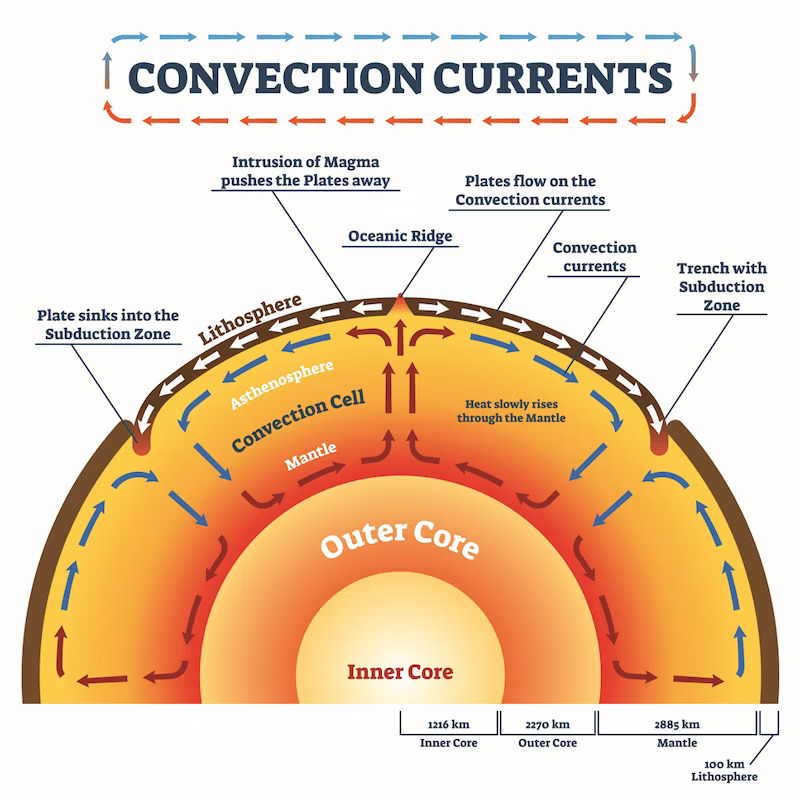
The gamut of lithospheric plates is as diverse as the Earth itself. They span from minor to major plates, encompassing continental plates, such as the Arabian Plate, oceanic plates, like the Pacific Plate, and hybrids merging continental and oceanic elements, exemplified by the Indo-Australian Plate.
Intriguingly, the movement of these crustal plates, propelled by the mantle’s convection currents, shapes our planet’s topography and serves as the prime instigator of geological activity.
Driving Plate Motion: Convection currents within the mantle, set in motion by thermal gradients, provide the impetus for the plates’ migration.
Rates of Plate Motion: The pace at which these plates journey varies substantially. For instance, the Arctic Ridge experiences a leisurely crawl, inching at less than 2.5 cm per year. In stark contrast, the East Pacific Rise in the South Pacific, situated approximately 3,400 km west of Chile, showcases the most rapid plate movement, surging at a remarkable rate exceeding 15 cm annually.

The theory of Plate Tectonics, like a masterful jigsaw puzzle, uncovers the intricate choreography of Earth’s lithospheric plates and their profound influence on the planet’s ever-evolving landscape.

Exploring Earth’s Majestic Tectonic Plates
Our planet’s dynamic crust is a patchwork of colossal tectonic plates, each contributing to the awe-inspiring narrative of Earth’s geological history. Let’s embark on a journey to discover the primary players in this Earthly saga:
- Antarctic Plate: Encompassing the frigid expanse of Antarctica and its encircling oceanic plate, this region, shrouded in icy mystery, is vital in the grand tectonic scheme.
- North American Plate: Dominating the northern reaches of the Western Hemisphere, this sturdy plate underpins the continents of North America.
- South American Plate: Its extensive coverage spans the South American continent, dictating the geological dynamics of this diverse and vibrant landmass.
- Pacific Plate: Commanding the vast Pacific Ocean, this plate carries the weight of countless islands and oceanic territories within its dominion.
- India-Australia-New Zealand Plate: Encompassing a triad of remarkable lands, this plate plays a pivotal role in the geological evolution of India, Australia, and New Zealand.
- African Plate with Eastern Atlantic Floor Plate: This immense plate governs the African continent, extending its influence into the eastern depths of the Atlantic Ocean.
- Eurasian Plate with Adjacent Oceanic Plate: Encompassing the Eurasian landmass and its neighboring oceanic territory, this plate is a major player in shaping the vast continental expanse.
Now, let’s delve into the intriguing dynamics of the Indo-Australian Plate:
The Indo-Australian Plate: A Multifaceted Player
The Indo-Australian Plate is a multifaceted actor in the tectonic theater, comprising the continental expanses of Peninsular India and the Australian continent. Its boundaries and interactions are as diverse as its geographical footprint:
- To the north, the Himalayan region forms a continent-continent convergence zone, where the plate interfaces with the Asian Plate. This interaction creates the awe-inspiring Himalayan mountain range.
- In the east, the plate extends through the Rakinyoma Mountains, situated in Myanmar, and ventures further eastward, converging along the Java Trench, forming a boundary with the adjacent Pacific Plate.
- The southeastern margin of the Indo-Australian Plate presents a unique configuration—an oceanic ridge in the southwestern Pacific Ocean. This geological feature contributes to the intricate puzzle of plate tectonics.
The plate’s boundary with the Antarctic Plate is defined by an oceanic ridge, indicative of a divergent boundary, stretching in a roughly west-to-east direction. This ridge seamlessly merges into a spreading site just south of New Zealand.
The Kirthar Mountains of Pakistan delineate the western margin of the Indo-Australian Plate. This boundary extends along the Makrana coast, spanning the coasts of Pakistan and Iran. Eventually, it joins the spreading site from the Red Sea rift, formed due to the divergence of the Somali Plate and Arabian Plate. This boundary continues southeastward, passing the Chagos Archipelago, which owes its existence to hotspot volcanism.
In the symphony of tectonic plates, the Indo-Australian Plate plays a multifaceted role, contributing to the Earth’s ever-evolving geological tapestry.
Unveiling the Role of Minor Tectonic Plates
In the grand narrative of Earth’s geological dynamics, minor tectonic plates are the unsung heroes, contributing their unique flair to the intricate ballet of continents. These understated players, although smaller in scale, wield significant influence on our planet’s ever-evolving geology. Let’s take a closer look at these minor actors:
- Cocos Plate: Nestled between Central America and the mighty Pacific Plate, the Cocos Plate bears witness to the awe-inspiring subduction zones of this region.
- Nazca Plate: As a silent observer between South America and the Pacific Plate, the Nazca Plate plays a crucial role in the seismic activities that characterize this boundary.
- Arabian Plate: Dominating the Saudi Arabian landmass, the Arabian Plate has a notable presence in the intricate jigsaw puzzle of the Middle East.
- Philippine Plate: Positioned between the Asiatic and Pacific Plates, the Philippine Plate defines the geology of the Philippine archipelago.
- Caroline Plate: Carved out between the Philippine and Indian Plates, this Plate resides north of New Guinea, contributing to the geological features of the region.
- Fiji Plate: Resting northeast of Australia, the Fiji Plate forms part of the oceanic mosaic surrounding the Australian continent.
- Turkish Plate: Lying at the crossroads of Europe and Asia, the Turkish Plate is a testament to the tectonic diversity of this unique region.
- Aegean Plate: Embracing the Mediterranean region, the Aegean Plate adds geological nuances to this historically rich area.
- Caribbean Plate: In the vibrant expanse of the Caribbean, this Plate holds the key to forming mesmerizing islands and seascapes.
- Juan de Fuca Plate: Snuggled between the Pacific and North American Plates, the Juan de Fuca Plate participates in the geological dramas of the Pacific Northwest.
- Iranian Plate: Influencing the geological composition of the Iranian landscape, this Plate is an essential player in the tectonic theater.
These minor plates are not isolated actors but products of the intricate interplay between major tectonic forces. The continental drift and converging major plates have given rise to these smaller counterparts, further enriching the diversity of geological phenomena.
The Dance of Tectonic Plates: Interaction Unveiled
Major geomorphological features, from majestic mountains to awe-inspiring oceanic ridges, result from the intricate interactions between lithospheric plates. Three primary modes of interaction define this geological choreography:
Divergence – The Constructive Edge:
- Along divergent edges, plates move away from each other, manifesting in shallow-focus earthquakes and volcanic formations.
- In oceanic settings, mid-ocean ridges, like the Mid-Atlantic Ridge, are born as basaltic magma erupts and separates the seafloor, creating new crust. This phenomenon, known as seafloor spreading, is fundamental to Earth’s crust formation.
- On continents, rift valleys emerge, with the East African Rift Valley being a prominent example, resulting from the African and Somali plates’ divergence.
Convergence – The Destructive Edge:
- In convergence, two lithospheric plates collide, leading to crumpling, folding, and the birth of folded mountains, such as the Himalayas.
- Subduction, or one Plate sliding beneath another, results in the formation of trenches. The subducted material heats up and gives rise to volcanic island arcs, continental arcs, and a dynamic equilibrium between crust formation and destruction.
Transcurrent – The Transform Edge:
- In these interactions, two plates slide past each other horizontally, resulting in deformation of the existing landform.
- In oceanic settings, transform faults are observed, often perpendicular to mid-ocean ridges. On continents, notable examples include the San Andreas Fault along the western coast of the United States.
These diverse modes of interaction between tectonic plates are the driving forces behind Earth’s most captivating geological features, including mountains, rift valleys, volcanic arcs, and fault lines. They shape the dynamic landscape we inhabit, each movement contributing to our planet’s ever-changing story.
Unveiling the Bedrock of Plate Tectonics: A Tale of Geological Wonders
In the captivating narrative of plate tectonics, a plethora of evidence converges to underscore the integrity of this fundamental geological theory. Let’s embark on a journey through the compelling clues and manifestations that support the grand concept of plate tectonics:
Paleomagnetism: Magnetic Whispers from the Past
- Our most compelling evidence hails from the study of paleomagnetic rocks. The orientation of iron grains within ancient rocks hints at the existence of a South Pole that once resided between present-day Africa and Antarctica, a phenomenon known as “polar wandering.”
Age of Rocks: Continents vs. Ocean Floor
- Earth’s story is etched in its rocks. On the continents, rocks as ancient as 3.5 billion years stand as witnesses to eons past. However, the ocean floor tells a different tale, with its oldest rocks barely reaching 75 million years. A journey towards the ridges reveals progressively younger rocks, a testament to the dynamic spread of the seafloor. This intriguing observation echoes the principles of seafloor spreading and plate tectonics, which scrutinize the interplay of oceanic plates.
Gravitational Anomalies: Glimpses of Subduction
- In trenches, where the relentless subduction process unfolds at convergent plate boundaries, gravitational anomalies emerge. These anomalies are detected through variations in the gravitational constant ‘g,’ signifying a mass loss. For instance, measurements around the Indonesian islands have unveiled significant gravity anomalies bordering the Indonesian oceanic trench.
Earthquakes and Volcanoes: Nature’s Dynamic Resonance
- A striking correlation emerges: all regions where tectonic plates meet bear witness to the seismic orchestra of earthquakes and volcanic eruptions. This symphony of geological unrest provides a resounding affirmation of the plate tectonics theory.
The Significance of Plate Tectonics: Shaping Our World
- Almost every major landform on our planet, from lofty mountains to meandering rift valleys, owes its existence to the relentless dance of tectonic plates.
- Within the depths of our planet, valuable minerals like copper and uranium are unearthed, enriched by the magmatic eruptions along plate boundaries.
- The past illuminates the future: our understanding of crustal plate movement allows us to forecast the evolving shapes of landmasses. The journey ahead portends North and South America parting ways, a new landmass detaching from the east coast of Africa, and Australia edging closer to Asia.
These profound revelations affirm the central role of plate tectonics in the dynamic narrative of our planet. The geological ballet continues, and our understanding of Earth’s ever-evolving tale deepens, guided by the enduring principles of plate tectonics.

